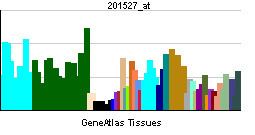Entrez 9296 | Ensembl ENSG00000128524 | |
 | ||
Aliases ATP6V1F, ATP6S14, VATF, Vma7, ATPase H+ transporting V1 subunit F External IDs MGI: 1913394 HomoloGene: 3119 GeneCards: ATP6V1F | ||
V-type proton ATPase subunit F is an enzyme that in humans is encoded by the ATP6V1F gene.
This gene encodes a component of vacuolar ATPase (V-ATPase), a multisubunit enzyme that mediates acidification of eukaryotic intracellular organelles. V-ATPase dependent organelle acidification is necessary for such intracellular processes as protein sorting, zymogen activation, receptor-mediated endocytosis, and synaptic vesicle proton gradient generation. V-ATPase is composed of a cytosolic V1 domain and a transmembrane V0 domain. The V1 domain consists of three A and three B subunits, two G subunits plus the C, D, E, F, and H subunits. The V1 domain contains the ATP catalytic site. The V0 domain consists of five different subunits: a, c, c', c", and d. Additional isoforms of many of the V1 and V0 subunit proteins are encoded by multiple genes or alternatively spliced transcript variants. This encoded protein is the V1 domain F subunit protein.
Subunit F is a 16 kDa protein that is required for the assembly and activity of V-ATPase, and has a potential role in the differential targeting and regulation of the enzyme for specific organelles. This subunit is not necessary for the rotation of the ATPase V1 rotor, but it does promote catalysis.
